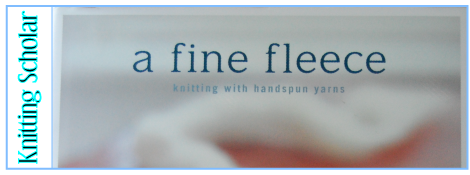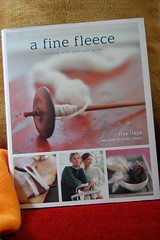First, the facts:
Title: A Fine Fleece
Author: Lisa Lloyd
Published by: Potter Craft, 2008
Pages: 159 p.
Type: A little Spinning, A little Knitting, a slew of Patterns
Chapters:
1. How to Use This Book
2. The World of Handspinning
3. Light and Shadow: Studies in Contrasts
4. The Forest and the Trees: Scale and Perspective
5. Conceptual Stitches and Emotive Design
Pattern Size Range: Varies, roughly35″ – 52″
The In-Depth Look:
The idea behind A Fine Fleece is simple–making things out of your handspun yarn, except, you don’t NEED to be a spinner.
Hmm, let me rephrase that. The patterns in this book can be made out of commercial yarn, or yarn of your own.
Maybe I should just let the author explain:
“Every piece in this book is shown in both handspun and a commercially available yarn. … Ultimately, I feel being a spinner has made me a better knitter simply by teaching me to see yarn differently. You don’t need to spin to enjoy this book, but if you have even the slightest interest in learning to spin, I urge you to act on it. Most knitters I know are fascinated with yarn and fiber and have well established favorites, either in gauge, yarn company, or type. Being a spinner takes all these things to the next level and beyond. Handspinning opens up unlimited possibilities of yarn. If you can imagine a yarn, you can make it. As a knitwear designer, spinning has added a depth to my design work I never imagined possible.”
The book begins talking about the basics–design, sizing, knitting rules, care of your knitting. Fairly standard … though, I love that her first rule of knitting “is there are no rules.” Except for swatching.
Chapter two talks about handspinning. This is NOT a how-to on spinning, but a general look at spinning itself, starting with wool. She explains the importance of breed, microns, crimp, staple-length–all the elements that go into wool yarn but that a non-spinner might not know about. Think about it–when is the last time you saw a commercially made sweater whose Fiber Content label gave specifics about the type of wool used–maybe it said lambswool, or merino, but chances are, it just said “Wool.” Well, the author makes sure you know that there’s more to it than that. Not to mention things like color, blending fibers, dyeing, twist, and gauge.
She doesn’t go into detail so much to explain it for a person who does not spin, but more like she’s putting it out there so that non-spinners can appreciate the flexibility available, and spinners will stop to think about what they can spin for a specific project. How to spin yarn for THAT sweater, or for THOSE socks, rather than aimlessly spinning and hoping for the best.
The real beauty of this book, though, is in its patterns. Every project is shown knitted in two yarns–one handspun, and one commercial yarn. The yarn is given in yardage and weight, with comments on the type of fiber for the handspun–often the inspiration for the pattern. Skill levels are (reluctantly) defined, and where necessary, there are notes about modifications or tricky design elements.
The designs themselves?
Pullovers. Cardigans. Scarves. Socks. Hats. Vests. Mostly sweaters, though, with designs for men as well as women (many can be made for both). Then there are the texures–lace and cables (especially cables) abound, and there is not a lot of stockinette stitch to be found. The Corduroy sweater is one of the simplest patterns in the book, stitch-wise, and even it has added texture from a welt pattern across the top. Town and Country is a delicious, classic Aran with cables everywhere, while Kearsarge is covered with a simple, basketweave pattern. Halcyon and St Patrick are more classicly shaped Arans, while Gaelic Mist just has cables on the lower half.
Generally speaking, there is very little shaping in any of these sweaters. Some have set-in sleeves, and there are one or two with a little waist-shaping, but mostly, the sweaters are classicly “boxy”. There are saddle shoulders, and drop shoulders, and a couple of raglans, but the shapes are mostly rectangular–the better to showcase those gorgeous cables. (Have I told you about my weakness for gorgeous cables?)
Luckily, every sweater comes with a clear schematic because the weakest part of the book is its photographs. They’re beautiful and evocative and a pleasure to look at, but they’re not really informative. The photo for the smoking jacket, for example, has the two models crowded into the front seat of a car, so that you can’t really see the details of the sweater. The girls wearing St. Patrick are leaning on a sled, and when they model Ruby? Carrying an armful of firewood. These are all photographic sins in my book because there’s no way to tell if they are carrying that firewood because the photographer thought it would look good or because there’s something funky going on at the waistline of that vest. Judging by the clear schematics, my guess is that it’s the photographer not the sweater, but … you can’t really be sure.
Would I let that stop me from getting this book? Oh, no. This fine book is on sale at Amazon for $19.80.
Want to see bigger pictures? Click here.




Comments on this entry are closed.
I like this book a lot as well, but mostly because it mentions the commercial yarns! I don’t spin (and have no interest), but the way this book is designed, I get just as much use out of it. Excellent!
That’s definitely one of its strong points–that it not only encourages handmade yarn (which I’m all for), but accepting that not every knitter is going to get hooked on spinning, and that that’s all right, too!
I just started Staghorn from this book this weekend (after being inspired by Knitting Park’s beautiful one). It is a lovely book, but you are dead right about the photos. It’s too difficult to judge the fit and style from nearly all of the photos. At least one of the sweaters looks as if it has waist shaping in the photo, but the schematic shows it does not.
Thanks again for this wonderful blog!
I heart this book. Haven’t knit anything from it yet. I am still drooling over the photos and patterns.
Kim´s last blog post..R is for
Thank you for reviewing this book. I absolutely love it!! I’ve been spinning for many years and have always been nervous about using my handspun. This book has really helped me a lot. I’m doing Tilly now, a beautiful cabled scarf, and definitely intend to do more.
Be careful with these patterns, especially the sleeves. Look carefully at them in the book and you will notice that most of them are quite big and will need fewer stitches for a nice fit.
I really really like your review. After reading it, I always would like to buy it… I don’t do it because no more space for book and my boyfriend say the floor is not a bookshelf…
My philosophy is that you can’t have too many books–only too little space!
I would have liked to have seen a WPI on the yarns, since some spinners will choose to handspin the yarn. Wish there was more guidance to achieve the desired gauge/weight in handspun.
Wish they included wraps per inch to help achieve the handspun yarn.
.-= ChelleC´s last blog ..Friday’s Find =-.